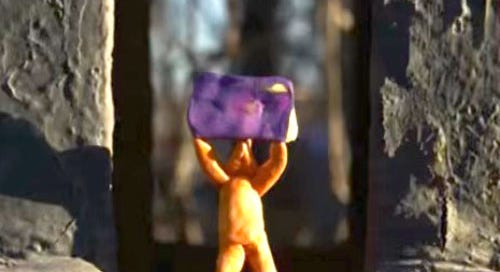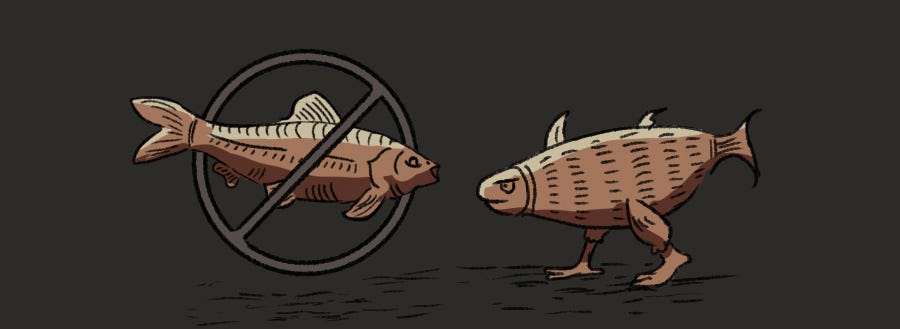Jun 18: Marco Hernandez, Decoding the Antiwar Messages of Miniature Protesters in Russia
As published in the Washington Post on June 16, 2023
Decoding the Antiwar Messages of Miniature Protesters in Russia
By Marco Hernandez, The Washington Post, June 16, 2023
With Putin’s crackdown on protests of the Ukraine war, people have found ways to express their opposition through small displays of resistance.
Fish, asterisks, blank messages and the crossed out Z letter: All of these are symbols of opposition to the invasion of Ukraine by Russia. In a country where public criticism of the war comes with the threat of incarceration, protesters have taken to social media to remain anonymous and adopted a secret language to convey dissent for the Kremlin.
Last year in St. Petersburg, an artist uploaded a few images of tiny clay figurines in a public space to Instagram under the account Malenkiy Piket, meaning Small Protest. In a separate post, he invited others to join him in his silent demonstration.
Since that post, he has received almost 2,000 images containing homemade figurines, many holding posters of protest with curious symbology. Contributors are able to preserve their anonymity by sending private messages in the app to the artist, who then posts their images. At its peak, the account received around 60 images daily, the artist told The Times.
Sending such pictures, even privately, carries enormous risk: Sharing antiwar messages can be a cause for imprisonment. Hiding figurines in public spaces could be captured by surveillance cameras. Police used CCTV footage to track and arrest one contributor in 2022.
Using strategic ambiguity to protest authoritarian governments is not unique to Russia: pro-democracy demonstrators in Hong Kong held up blank signs as a form of protest, and social media users in China used the candle emoji to commemorate the anniversary of the Tiananmen Square massacre.
The artist told The Times that it’s important for people to see that Russians oppose the war, too. “Not everyone is with Putin. We know how the media just skips this, cuts out everything that shows people against it.”
The messages in the images
FISH
In 2022, a woman was arrested for writing “нет в***e” in graffiti in a public square, putting asterisks instead of letters in some places. The police believed she had intended to write the word “война” for war, but the woman said she had written “вобла,” a fish native to the Caspian Sea that Russians traditionally eat with beer or vodka.
The story went viral, producing tons of memes and even a song. The woman was eventually fined, but by then, her story had already turned the vobla fish and asterisks into symbols of protest.
BLANK POSTERS
Blank posters underscore how Russia has criminalized free speech. During the first months of 2022, after Russia invaded Ukraine, many Russians took to the streets with blank posters, and the police arrested them.
ANTIWAR FLAG
Recognized as an antiwar symbol, the white flag with a blue stripe in the middle was created by Russians who opposed the invasion of Ukraine and disapproved of Putin’s government.
THE CROSSED OUT Z
Members of the Russian army emblazon their tanks and trucks with the letter Z to differentiate themselves from Ukrainians in the field. Many of Malenkiy Piket’s images show the letter Z crossed out.
PEACE
About a hundred images shared by Malenkiy Piket show the peace sign.
MESSAGES IN RUSSIAN
Most of the figurines hold messages written in Russian. Malenkiy Piket said that most of the images he received were from people living in Russia, but many were sent from Ukraine and other former Soviet states.
INTERNATIONAL SUPPORT
Hundreds of images show the Ukrainian flag. Hundreds more have messages written in English, Spanish, Italian, Portuguese and other languages.
“These little men did what it became impossible for us to do openly. And I saw that there are people who, like me, are against this war,” said a contributor, an activist who lives in Russia.
She explained that she searches for a public place where there are no cameras and waits for the moment when no one is around. “I take a photo and quickly leave. It's like a game sometimes,” she said. “And it would be fun if not for the context.”
Another contributor said she was inspired to send images to Malenkiy Piket because she said her images can last longer than the street protests, which were broken up by the police long ago.
“It’s important also for people like myself to see that I’m not alone,” she said.














